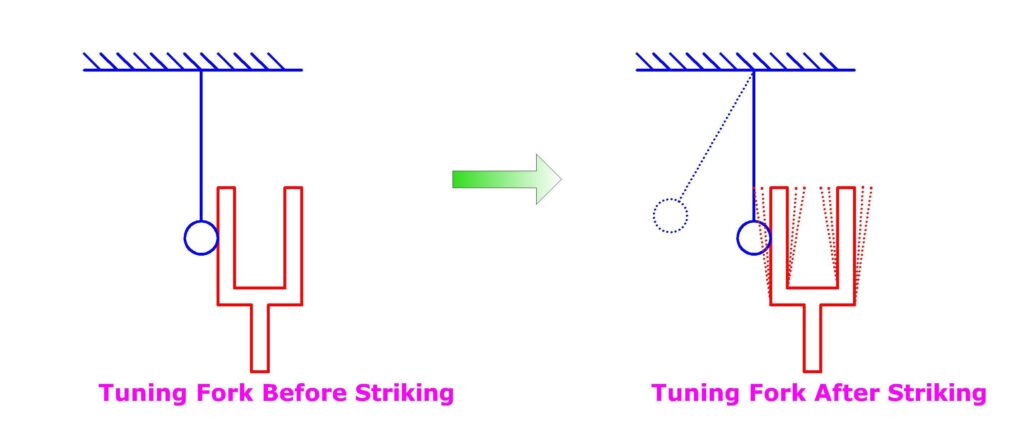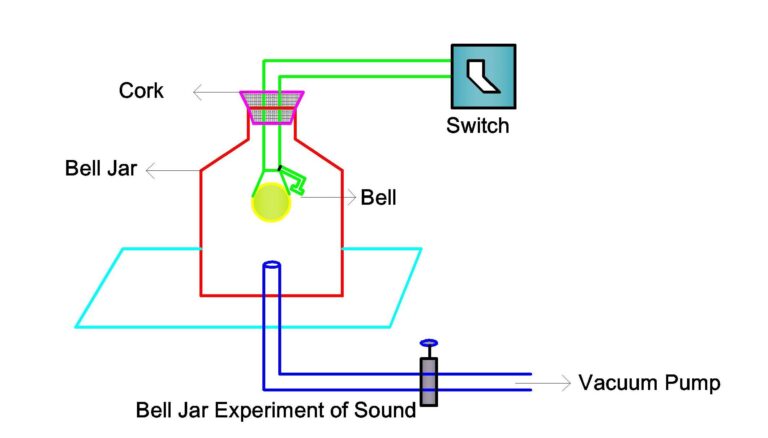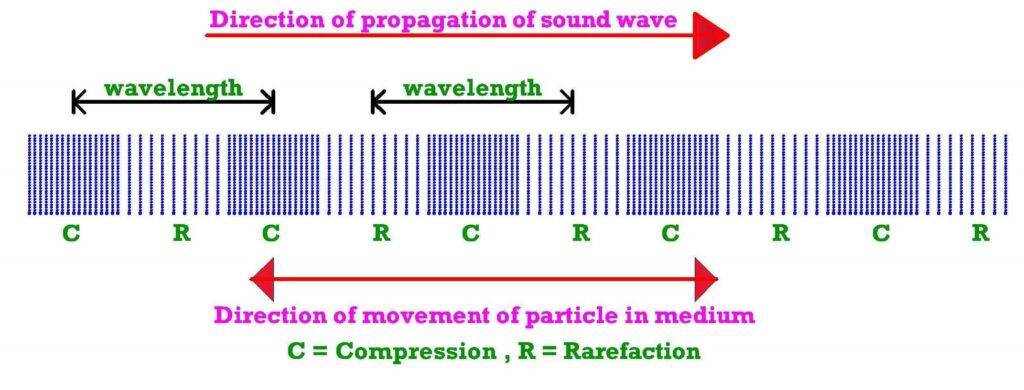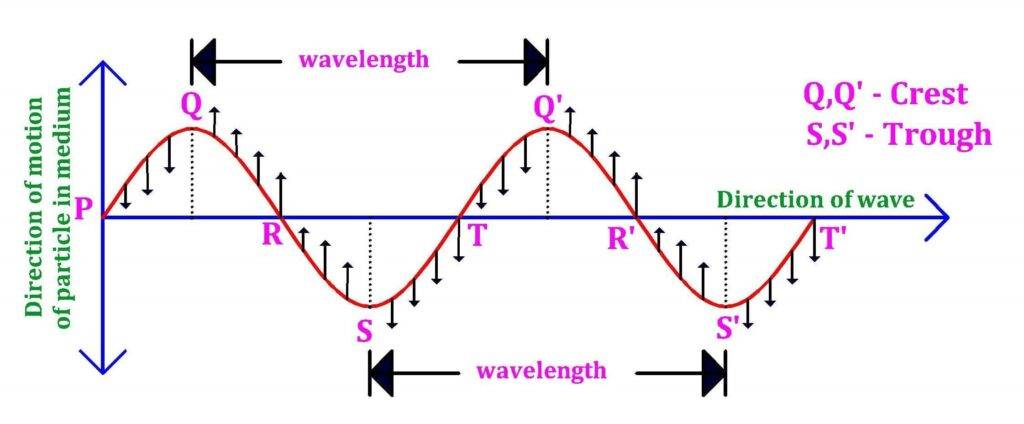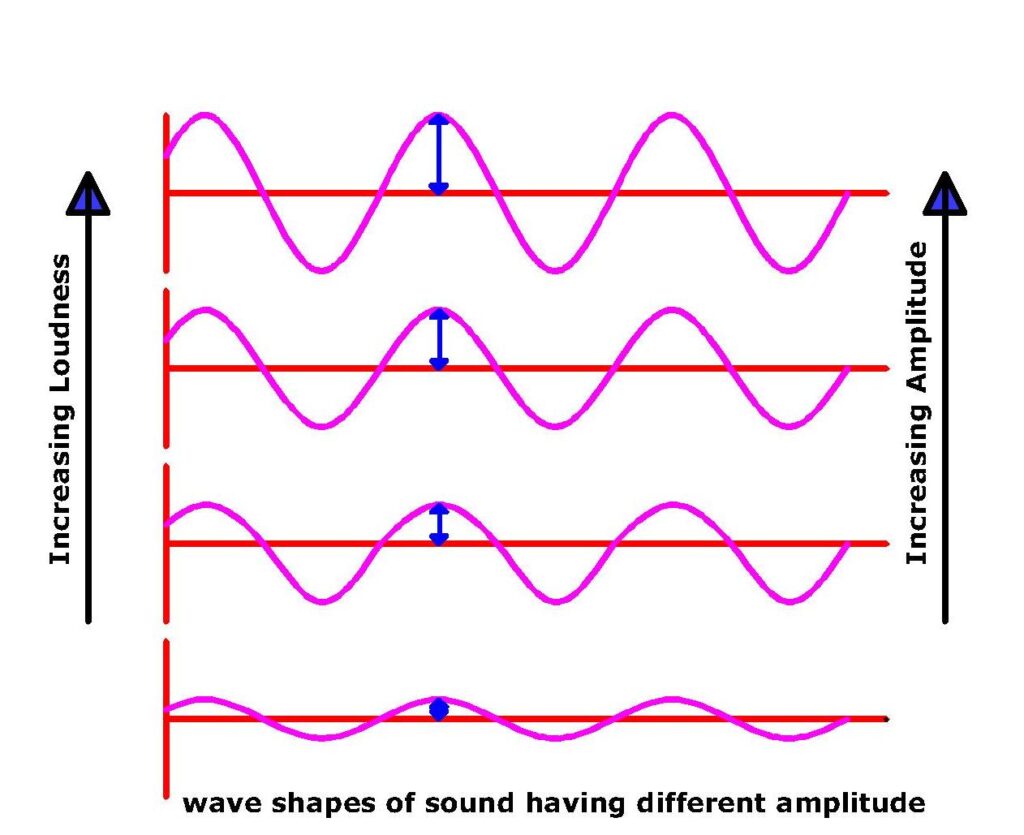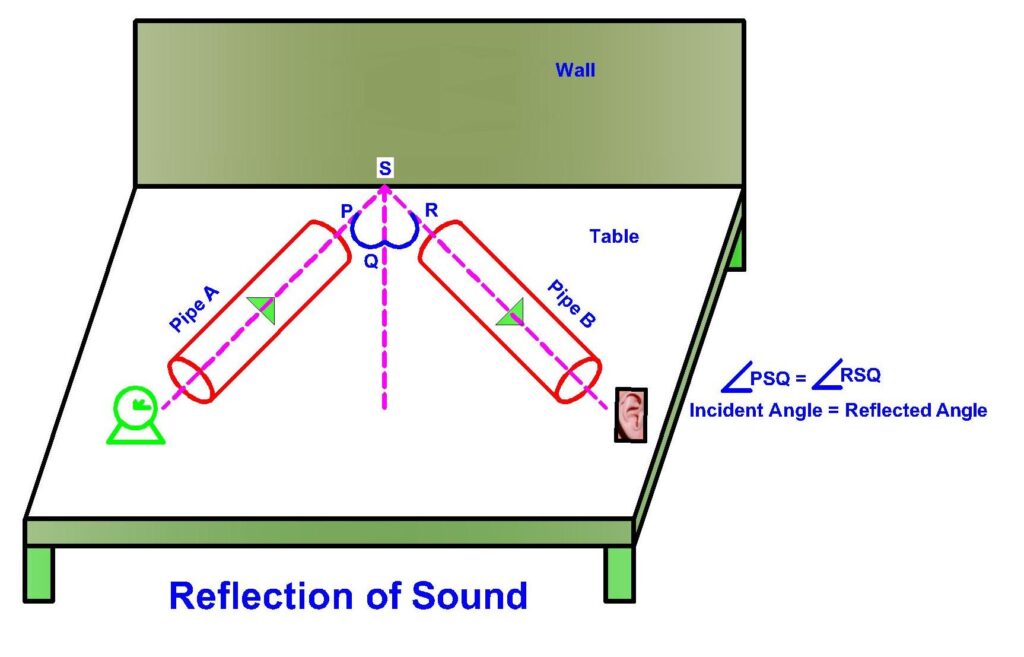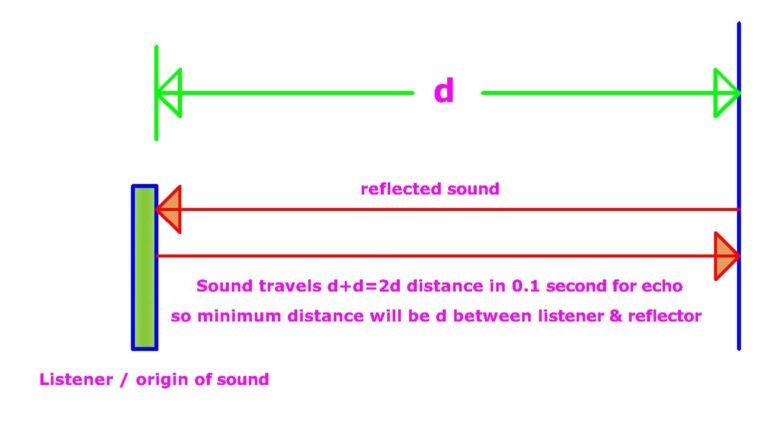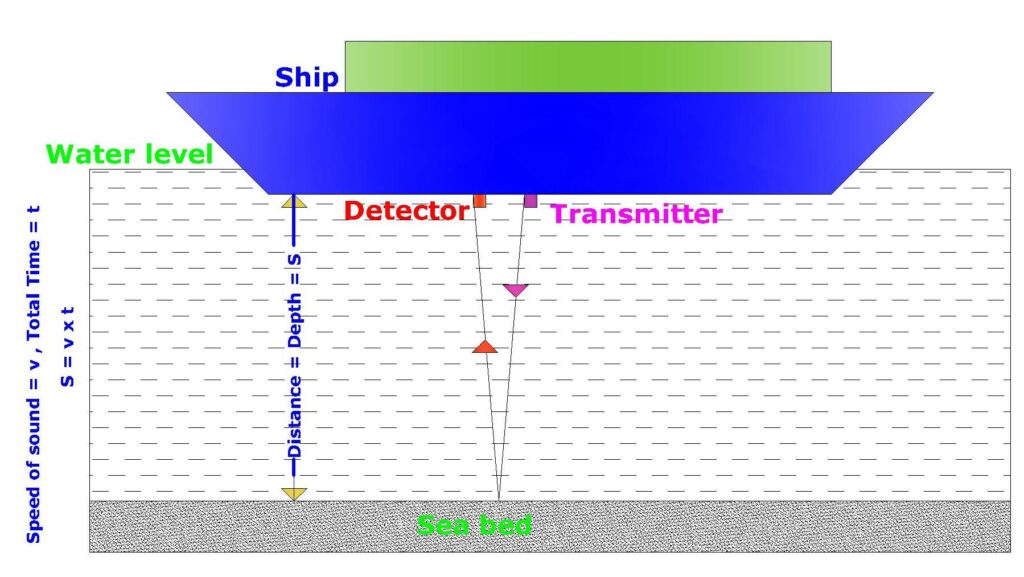Sound Class 9 Science NCERT Chapter 12 | In-Text Questions & Answers | Exercises Questions & Answers | Notes & pdf
Q1. What is sound?
We hear different type of sounds everyday such as sounds from talking, car, music, machine, bells, birds etc. Some sounds are euphonic and some are grating. Sound is also a form of energy like heat, light etc. We can not see sound like heat but we can hear it. As per law of conservation of energy, energy can not be created nor destroyed. Energy only can be changed from one form to another. Sound produced from vibration of an object is also a form of another energy. Sound needs medium for propagation. The energy which is emitting from any vibrating object and propagating through material medium (solid or liquid or gas ) and producing hearing sensation in ear is called sound.
Q2. How sound is produced?
Vibration of an object produces sound. Drop a steel plate on floor, you will hear sound. Now touch the plate, you will find the plate vibrating. So vibration of plate is producing sound in this case. When we talk, our vocal chord vibrates.
To and fro motion –
Strike prong of a tuning fork by rubber pad or wrapped wooden hammer. Tuning fork will start vibrating and it will produce sound. Now suspend a tennis ball as shown in above picture. The ball moves away every time it touches prong. As fork is vibrating, it strikes the ball every time the ball touches it’s prong. So movement of the ball proves vibration of the fork and vibration of the fork is producing a sound. Flying of bee produces sound by continuous vibration of it’s wing. We may term sound producing as ‘to and fro’ motion of an object. You may produce sound in many other ways like scratching, rubbing etc. But everything is associated with vibration.
Q3. How does sound propagate through medium?
Sound needs medium for propagation. Medium may be solid or liquid or gas. Sound can not propagate through vacuum like light. It always requires any kind of medium. As vibrating object produces sound, so sound moves from origin to listener through medium. Medium (solid or liquid or gas) contains tiny particles. During vibration of sound producing object, particles of medium adjacent to the object start vibrating. First vibrating objects exert force to the adjacent particles to displace them from their equilibrium position. Then displaced particles exert force to their adjacent particles and return to original position. And it continues till sound reaches to the listener. Thus we find that sound or disturbance created by the vibrating object reaches to the listener through medium but particles of medium do no change their position.
Propagation like waves ⇒
Vibration in object creates a disturbance which sets adjacent particles of medium into motion by exerting force. That particles set neighbouring particles in motion and return to equilibrium position. And this process continues and the disturbance is carried forward but particles in medium do not change their position. In other words we may term it as wave. Actually wave is a disturbance which propagates through a medium when particles of that medium induces motion to their neighboring particles. Sound also propagates like waves i.e. through motion of particles of the medium. Also we term these waves as mechanical waves.
Compression and Rarefaction ⇒
Let imagine propagation of sound wave in air. Vibrating object produces forward and backward motion. When it moves forward, it compresses adjacent air and creates a region of high pressure. That region is called a compression (‘a’ in picture) and it starts to move away from the vibrating object. When the vibrating object moves backwards, it creates region of low pressure and that region is called a rarefaction (‘b’ in picture). As the object produces forward and backward motion continuously, so it creates a series of compression and rarefaction which makes propagation of sound wave through the medium (‘c’ in picture). A high pressure region (compression) is actually a region of high density of particle in the medium and a low pressure region (rarefaction) is actually a region of low density of particle in the medium. So you may imagine propagation of sound wave as density or pressure variations in medium i.e. series of high density region and low density region.
Q4. Does sound can propagate through vacuum?
Sound needs medium (solid or liquid or gas) for propagation and it can not propagate through vacuum like light. We can prove it in following bell jar experiment.
An electric bell is fitted in a airtight glass bell jar as shown in above picture. A vacuum pump is also connected to the bell jar. The bell is suspended inside the jar and electric connection is taken out from the jar and connected to a switch. Now press the switch. The bell will start ringing and you can hear sound. Now start the vacuum pump. The pump will extract air from the jar gradually and the sound becomes fainter though the bell is drawing same current as previous and ringing at same level . When the jar becomes almost airless, then you can hear a very feeble sound. If the jar is made fully vacuum, then you can not hear any sound though the bell is ringing. So it proves that sound can not propagate through vacuum.
Q5. What is longitudinal wave?
Longitudinal waves is the one in which particles of the medium move in the direction of propagation of wave i.e. parallel to the wave propagation. The particles in medium do not change their position and it only moves forward and backward about their position of rest or equilibrium. Sound wave is longitudinal wave and it propagates in aforesaid manner. Go through Q3 for details. Distance between two consecutive compression or rarefaction is the wavelength as shown in the picture.
Q6. What is transverse wave?
If you through a pebble in the middle of a pond, waves are created on water surface and that waves reach bank after few seconds. Motion of the particles in water helps to propagate the wave from middle of the pond to it’s bank. Throwing of pebble in the middle of a pond creates a disturbance and the disturbance, by exerting force, sets adjacent particles of medium into oscillating up and down about their mean position. That particles set neighbouring particles in oscillation. And this process continues and disturbance is carried forward. But particles in medium do not change their position and it only oscillates up and down about their position of rest or equilibrium in a direction perpendicular to the direction of wave propagation. And this type of wave is known as transverse waves.
Following picture depicts a transverse wave ⇒
In this case we see that direction of the motion of particle is perpendicular to the direction of wave propagation. Position of different particles are shown with arrows along with particles P, Q, R, S, T, Q’, R’, S’, T’. We term Q and Q’ points as crest of the wave and these points indicate maximum displacement towards positive side. In addition we term S and S’ points as trough of the wave and these points indicate maximum displacement towards negative side. Distance between two consecutive crest or trough is called the wavelength as shown in the picture.
Q7. Discuss speed, frequency, amplitude and time period in sound.
Basically we have learnt in Q2 and Q3 about propagation of sound. Generally we can represent sound wave propagation as a curve of density or pressure variation versus distance as shown in following picture. Propagation of sound wave is a series of compression and rarefaction. Compression is a high pressure zone where density of particle is high. And maximum compression zone is indicated as peak which is also called crest of wave. Rarefaction is a low pressure zone where density of particle is low. And maximum rarefaction zone is indicated as valley which is also called trough of wave.
The curve clearly shows that how density variation takes place i.e. from maximum value to minimum value and again minimum value to maximum value. The density variation from maximum value to minimum value and again minimum value to maximum value makes one complete oscillation.
Amplitude ⇒
From propagation curve we get that crest shows maximum disturbance towards positive (i.e. compression) side from equilibrium position and trough shows maximum disturbance towards negative (i.e. rarefaction) side from equilibrium position. The magnitude of these maximum disturbance is the amplitude of the wave.
Wavelength ⇒
It is the distance between two consecutive compression or rarefaction. Basically wavelength is the distance of one complete oscillation. Greek letter lamda λ represents wavelength of the wave. S.I. unit of wavelength is metre (m).
Frequency ⇒
Actually frequency is the number of complete oscillation per unit time i.e. in one second. Greek letter nu ν represents frequency of the wave. S.I. unit of frequency is hertz (Hz). We also express frequency by f.
Time Period ⇒
Time period is the time taken for one complete oscillation i.e. time taken to cross a fixed point by two consecutive compression or rarefaction. It is represented by T. S.I. unit of time period is second (s).
Speed of Sound (V) ⇒
Wavelength (λ) is the distance covered by the sound wave in one complete oscillation i.e. in T seconds. So in one second no. of complete oscillation is ν i.e. frequency of the wave. So in one second the wave propagates (ν x λ) metre which is called speed of that wave.
Therefore, speed of sound v = ν x λ = frequency x wavelength.
Q8. What is the relation between Time Period (T) and Frequency (ν) of sound wave?
We know frequency (ν) is the number of complete oscillation per second and one complete oscillation takes T seconds. So total no. of oscillation in one second will be 1/T nos. which is actually frequency (ν) of the wave. So
V = 1/T ,
⇒ Frequency (ν) = 1 / Time Period (T)
Q9. What is pitch of a sound?
Sound has some different characteristics and pitch is one of them. Basically pitch of a sound depends on the frequency of the sound wave. The higher the frequency, the higher is the pitch. And higher frequency indicates that sound producing object is vibrating fast. Generally it means that number of compression and rarefaction passing a fixed point in the medium per unit time is more.
Let play different musical instruments such as drum, guitar, flute etc. at same time and all the sounds is reaching to the listener through same medium (take air in this case). We know speed remains same in a certain medium irrespective of source . Now all the sounds reach to the listener at the same time. The brain of the listener will interpret and recognise all sounds differently as frequency i.e. pitch of all the sounds produced by drum, guitar, flute etc. are not same and different with each other.
Q10. What is loudness of a sound?
Previously we have learnt amplitude in Q7. Basically loudness or softness depends on the amplitude of sound wave. Amplitude of different sound waves produced by different objects vary with each other. This means amplitude of sound wave produced by a guitar and amplitude of sound wave produced by a drum will be different. The more the amplitude, the louder is the sound. We know sound is also a form of energy. The more the energy, the louder is the sound i.e. magnitude of amplitude is more. So louder sound i.e. associated with high energy can travel more distance and reaches to remote listener.
Q11. What is tone and note of a sound wave?
Normally object in vibration produces a mixture of several frequencies. A tone is a sound of fixed frequency. Tuning fork in vibration produces a tone i.e. a sound of single and fixed frequency. On the other hand a note is a sound of multiple frequencies. Actually note is a mixture different tones. And different tones of a note are called overtones. Generally any kind of musical instrument produces sound having multiple frequencies i.e. note.
Q12. What is overtone and harmonics of a sound wave?
Let assume a note of overtones having frequencies of 100 Hz, 150 Hz, 200 Hz, 300 Hz, 330 Hz, 400 Hz, 500 Hz. The tone having lowest frequency is the fundamental tone. In this case tone having frequency 100 Hz is the fundamental tone. Tones having frequency of simple multiple of fundamental tone are the harmonics. In this case 200 Hz, 300 Hz, 400 Hz, 500 Hz are harmonics as all these are simple multiple of fundamental tone (i.e. 200 Hz = 2 x 100 Hz, 300 Hz = 3 x 100 Hz, 400 Hz = 4 x 100 Hz, 500 Hz = 5 x 100 Hz). But 150 Hz, 330 Hz are not harmonics as these are not simple but complex multiple of fundamental tone (i.e. 150 Hz = 1.5 x 100 Hz, 330 Hz = 3.3 x 100). So we may say that all harmonics are overtones but all overtones are not harmonics.
Q13. What is quality of a sound?
Basically the characteristic that differentiates various sounds having same pitch and loudness is the quality of that sound. Actually quality of a note depends on the number of overtones present in it. If number of overtones present in a sound is more, then quality of tone is high and pleasant. Also relation between pitch and loudness of fundamental tone with the harmonics affects quality of a note.
Q14 . Discuss speed of sound in different medium.
Generally the speed of sound varies in different medium though speed almost does not alter in a given medium for all frequencies under same physical condition. Speed of sound is maximum in solid medium and minimum in gaseous medium. Speed of sound in liquid medium is higher than gas but lower than solid. Various factors such as temperature, density etc. affect the speed of sound.
Following factors affect the speed of sound in gas ⇒
A. Temperature: Basically speed of the sound in gas increases with increase in temperature. If V0 is the speed at 0oC in gaseous medium, then speed at toC will be Vt = V0 (1 + 0.00183t). Speed of sound at 0oC in air is 332 m/s , then at toC speed will be Vt = 332 (1 + 0.00183t) m/s.
B. Pressure: Speed normally remains unaltered if pressure varies in gaseous medium.
C. Density: Speed is inversely proportional to the square root of density of medium. Density of oxygen is 16 times of hydrogen. The speed of sound in oxygen will be 1/√16 i.e. ¼ times the speed in hydrogen.
D. Humidity: Normally speed increases with increase in humidity in gaseous medium.
Q15. What is Newton’s formula related to speed of sound and what is Laplace’s correction in Newton’s formula?
At first Newton established an equation to find the speed of sound in gaseous medium. As per Newton’s formula: V = √(P/D) [Here V = sound’s speed in gas, P = gas pressure, D = density of gas].
But when we derive speed of sound in air, this equation does not satisfy the result. Let find the speed of sound in air at standard atmospheric pressure and temperature.
Standard atmospheric pressure = 760 mm Hg = 76 cm Hg = 76 x 13.6 x 980 dyne/cm2. Density at standard atmospheric temperature(0oC) = 0.001293 gram/cm3. So speed of sound –
V = √ [(76 x 13.6 x 980) / 0.001293] cm/s = 280 m/s.
But this result does not match the actual speed of sound as speed of sound in air at standard atmospheric pressure and temperature is 332 m/s. So it clearly expresses shortcomings of Newton’s formula. Later Laplace corrected Newton’s formula and put new equation as –
V = √(K.P/D) [ where K is a constant and value of K is 1.41 ].
If we again calculate the speed of sound in air at standard atmospheric pressure and temperature as Laplace’s equation, we will find: V = √ [(1.41 x 76 x 13.6 x 980) / 0.001293] cm/s = 332.5 m/s. This satisfy the actual speed of sound in air at standard atmospheric pressure and temperature .
Q16. Discuss reflection of sound.
Sound also has reflection properties like light. Sound needs a widespread surface to get reflected such as building, wall, hilly terrain etc. A small mirror can reflect light but sound needs big surface of solid or liquid to get reflected. As sound’s wavelength is much higher than light, so it needs bigger surface for reflection. It follows same rule of reflection like others where direction of incidence and direction of reflection make equal angles with the normal to the reflecting surface at the point of incidence (i.e. ∠angle of incidence = ∠angle of reflection). Let do following experiment –
Put two identical cylindrical pipes A and B horizontally on table as shown in the picture. After that bring the table near a wall or fix a wooden board perpendicularly on table. Also arrange both pipes in such way that their axis terminate at point S on wall and make equal angles with SQ line i.e. ∠PSQ = ∠RSQ. SQ line is perpendicular on wall. After that put a clock at open end of pipe A and try to hear the sound of the clock at open end of pipe B. Sound produced by the clock will propagate through pipe A and get reflected on wall and finally reach to the listener through pipe B. You will hear best sound when angle of incidence is equal to angle of reflection i.e. when ∠PSQ = ∠RSQ . If you try to change the position of pipe B towards left or right, you can hear very mild sound of the clock or you can not hear any sound.
Q17. Give some examples of application of reflection of sound in our daily life.
1) Specifically Doctors use stethoscope to listen sound from heart or lungs of patient. Sound produced by heart or lungs reflects multiple times inside the tube. Similar happens in speaking tube which is used for conversation between driver and passenger in a big car.

2) Curved or concave surface: Generally we make curved ceiling in a big hall to reflect sound to spread sound all over the wall. Before the invention of loudspeaker, generally the speaker gives speech standing in front of a concave board or wall, so that sound can reflect and spread out. Sometimes we bend our palm to listen remote sound. In this case palm works as concave reflector. Megaphone, horns etc. use principle of reflection of sound.
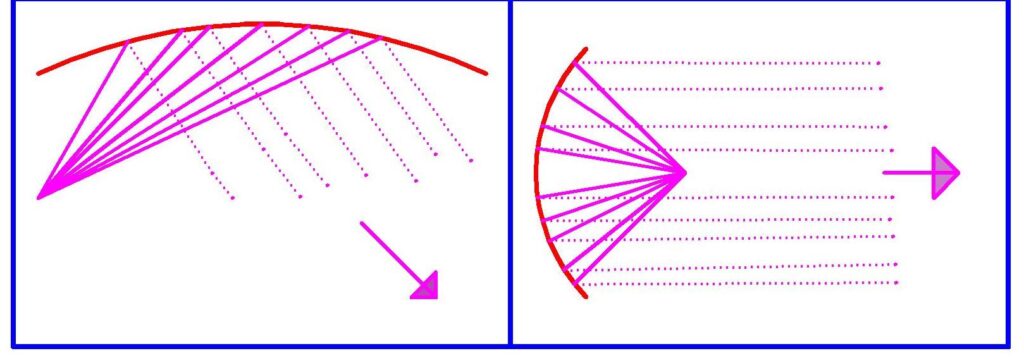
Q18. What is echo and how do you calculate minimum distance for echo in air?
Sometimes if we shout standing in front of tall building, hill, river bank etc., we hear same sound after a little time. It is echo of the original sound. Actually echo is the reflection of original sound. Any sound persists in our brain for 1/10 seconds i.e. 0.1 seconds. So for echo, the reflected sound should reach to the listener after 0.1 seconds of original sound. If reflected sound reach to the listener within 0.1 seconds of original sound, our brain can not differentiate original and reflected sound. As a result, we can not hear any echo.
Minimum distance for echo in air ⇒
Take speed of the sound as 340 m/s in air. Sound travels in 0.1 second is 340 x 0.1 = 34 metre. Now to hear echo, sound must travel 34 metre. That means sound should take 0.1 second to reach to the listener after reflection. So minimum distance between the listener and reflecting wall should be 34/2 i.e. 17 metre. Specifically observe the following picture. If the distance between the listener and reflecting wall is d, then sound should take 0.1 second to cover 2d distance.
Q19. What is reverberation?
Especially sound produced in auditorium or big hall persists for sometime due to multiple reflection from the wall and ceiling. We term it as reverberation. One can keep hearing reverberation until sound reaches inaudible level. Sometimes thunder sound persists for sometime due to multiple reflection at various layer in clouds. Particularly, we use sound absorbing material in walls, roofs, seats to reduce reverberation in hall .
Q20. What is Mach number and supersonic speed?
If the speed of any object (especially fighter aircraft) becomes greater than the speed of sound, then that speed is the supersonic speed. Mach number is the ratio between the speed of any object and the speed of sound. Generally we express speed of the fighter aircraft in Mach number.
Q21. What is audible range of human?
We hear various type of sound in our daily life. Human being can hear sounds of frequency particularly from 20 Hz to 20 KHz i.e. from 20 Hz to 20,000 Hz. Range of frequencies created by our conversation is 90 Hz to 13 KHz. Normally aged people can not hear high frequency sound due to ageing but children under five years can hear sound of frequency up to 25 KHz sound.
Q22. What is infrasonic sound?
Audible range of human being is 20 Hz to 20 KHz. Sound of frequency below 20 Hz is not audible to us and this sound is the infrasonic sound. Some animals like elephants, whales, rhinoceroses etc. communicate using infrasonic sound. Due to this capability, some animals get disturbed before earthquake as earthquake produces infrasonic sound before main shock waves.
Q23. What is ultrasonic sound?
Sound having frequency greater than 20 KHz (i.e. 20,000 Hz) is the ultrasonic sound or ultrasound. Ultrasound in various fields is extensively used in present day. Animals like bats, dolphins, rats can produce ultrasonic sound.
Q24. Give some example of applications of ultrasonic sound.
Ultrasound can be deadly for germs and it is used for sterilisation of drinking water, milk etc. It is also used to detect inner cracks in metal blocks, bridges, buildings etc.
Ultrasound is used in cleaning of out of reach parts located inside of various devices, electronic components, instrument etc. At first high frequency sound wave is propagated through cleaning solution where object is put in to be cleaned. Thereafter that high frequency wave detaches dust particles and others from the object.
Medical Diagnostic Equipment:
Ultrasonic wave is extensively used in medical diagnostic equipment for test like USG (ultrasonography), echocardiography etc. Ultrasonic wave is propagated through tissues of our organs and made to reflect where there is density variation of tissues. That reflected wave is then converted into electrical signals to produce images of organ. Sometimes it is used to break stones into smaller ones in kidney to flush out with urine.
SONAR System:
SONAR System is used to measure the depth of sea or river and to detect under water objects like submarines, icebergs, hills etc. We also term it as echo-ranging. SONAR means sound navigation and ranging. It is a combination of a detector and a transmitter and is installed in ships. Sound originated from the transmitter travels up to sea bed and reflects back to the ship which is detected by the detector. If total time taken by the sound is t and speed of sound in water is v and depth of the sea is S, then total distance covered by the sound from transmitter to sea bed to detector ⇒ S+S = 2S = v x t.
Q25. Describe structure of human ear.
Ear is an extremely sensitive organ of human. It helps us to hear. Basically our ear converts air pressure variations with audible frequencies into electrical signals. Later that electrical signals travel to our brain. At first observe following picture.
Pinna is the outer ear and collects sound from the surroundings. After that the collected sound travels through auditory canal and reaches to the ear drum. Ear drum is a thin membrane and also called tympanic membrane. The ear drum is forced to move inward as soon as a compression of the medium reaches to the ear drum. Conversely the ear drum moves outward in case of rarefactions. These compressions and rarefactions set the ear drum into vibration. Later three bones i.e. A. hammer, B. anvil and C. stirrup in the middle ear, amplify said pressure variations several times. It then transmits amplified pressure variations to the inner ear. After that cochlea of the inner ear converts amplified pressure variations into electrical signals. These signals travel to the brain via the auditory nerve and finally our brain interprets them as sound.
In-Text Questions & Answers | NCERT Science Chapter 12 | Sound Class 9 Science
In-Text Questions & Answers | NCERT Science Chapter 12 | Sound Class 9 Science | Page No. 162
1. How does the sound produced by a vibrating object in a medium reach your ear?
Any vibrating object creates disturbance in the medium. This disturbance produces compression & rarefaction in the medium. As a result sound reaches to our ear.
1. Explain how does school bell produce sound.
When we hit the bell by a wooden hammer, it then starts vibrating. The vibration of the bell creates compression & rarefaction in air which results in production of sound.
2. Why sound waves are called mechanical waves?
Basically a mechanical wave always needs a material medium to propagate. Sound waves also need a material medium (solid/liquid/gas) to propagate. So sound waves are called mechanical waves.
3. Suppose you and your friend are on the moon. Will you be able to hear any sound by your friend?
Sound needs a material medium for propagation. There is no atmosphere on the moon. So propagation of sound is not possible on the moon. Hence, I will not hear any sound produced by my friend on the moon.
In-Text Questions & Answers | NCERT Science Chapter 12 | Sound Class 9 Science | Page No. 166
1. Which wave property determines ⇒ (a) loudness, (b) pitch?
A. Loudness ⇒ It is determined by the amplitude of the sound wave. Louder sound has greater amplitude & soft sound has lower amplitude.
B. Pitch ⇒ Frequency of a sound wave determines the pith of that sound.
2. Guess which sound has a higher pitch ⇒ guitar or car horn?
Pitch of a sound is proportional to its frequency. The frequency of the sound of a horn is more than the frequency of the sound of a guitar. So the car horn has a higher pitch than a guitar.
In-Text Questions & Answers | NCERT Science Chapter 12 | Sound Class 9 Science | Page No. 166
1. What are wavelength, frequency, time period & amplitude of a sound wave?
Wavelength is the distance between two consecutive compression or rarefaction. Basically wavelength is the distance of one complete oscillation. Greek letter lamda λ represents wavelength of the wave. S.I. unit of wavelength is metre (m).
Frequency is the number of complete oscillation per unit time i.e. in one second. Greek letter nu ν represents frequency of the wave. S.I. unit of frequency is hertz (Hz).
Time period is the time taken for one complete oscillation i.e. time taken to cross a fixed point by two consecutive compression or rarefaction. It is represented by T. S.I. unit of time period is second (s).
The magnitude of the maximum disturbance or displacement of a vibrating particle of the medium from the mean position is the amplitude of the wave.
2. How are the wavelength & frequency of a sound wave related to its speed?
Wavelength (λ) is the distance covered by sound wave in one complete oscillation i.e. in T seconds. So in one second no. of complete oscillation is (1/T) = ν. It is called frequency of the wave. We also express frequency by f. So wave propagates in one second = ν x λ = speed of the wave.
Therefore, speed of sound v = ν x λ = f x λ = frequency x wavelength.
3. Calculate the wavelength of a sound wave whose frequency is 220 Hz & speed is 440 m/s in a given medium?
In this case, f = 220 Hz, v = 440 m/s, wavelength = λ = v/f. So, λ = (440/220) m = 2 m.
4. A person is listening to a tone of 500 Hz sitting at a distance of 450 m from the source of the sound. What is the time interval between successive compressions from the source?
Given that, frequency = f = 500 Hz. Time period = T = ?
We know, frequency = 1/Time period,
⇒ Time period = 1/frequency = 1/500 sec = 0.002 sec.
In-Text Questions & Answers | NCERT Science Chapter 12 | Sound Class 9 Science | Page No. 166
1. Distinguish between loudness & intensity of sound.
The average energy transported per unit area perpendicular to the direction of propagation is the intensity. Loudness of sound depends on its intensity. But their relation is not linear. Loudness depends on the amplitude of sound wave. The more the amplitude, the louder is the sound. On the other hand intensity is the rate of power transferred per unit area & is determined by frequency of sound wave.
In-Text Questions & Answers | NCERT Science Chapter 12 | Sound Class 9 Science | Math related to speed of sound
1. Speed of sound at 760 mm Hg pressure and at 0oC is 332 m/s. What will be the speed of sound at 35oC? What will be the speed if pressure changed to 700 mm Hg?
We know Vt = V0 ( 1 + 0.00183t). Here V0 = 332 m/s. t = 35oC.
So V35oC = 332 ( 1 + 0.00183 x 35) m/s = 353.26 m/s.
2. A man standing on the bank of a river fires a gun. Another man standing on the opposite bank of the river hears the sound after 5 seconds of watching the flash of the gun. Calculate the width of the river if the speed of sound is 310 m/s.
Here the distance travelled by the sound in 5 seconds is the width of the river. So width of the river = 5 x 310 m = 1550 m.
3. Sound of a thunder is heard after 7 seconds of the flash of the light is seen. Find the distance of the cloud from ground level if the speed of sound is 340 m/s.
Distance = 7 x 340 m = 2,380 m.
4. What is the frequency of a sound wave having wavelength 1.7 m and speed 340 m/s.
As speed = frequency x wavelength, so frequency = speed / wavelength. Therefore, frequency ν = V/ λ = 340/1.7 Hz = 200 Hz.
In-Text Questions & Answers | NCERT Science Chapter 12 | Sound Class 9 Science | Page No. 167
1. In which of the three media ⇒ air, water or iron, does sound travel the fastest at a particular temperature?
In this case, sound travel fastest in iron at a particular temperature.
In-Text Questions & Answers | NCERT Science Chapter 12 | Sound Class 9 Science | Page No. 168
1. An echo is heard in 3 s. What is the distance of the reflecting surface from the source, given that the speed of sound is 342 m/s.
Given that speed of sound = 342 m/s. Also echo is heard in 3 s. So the distance travelled by the sound in 3 s = 342 x 3 m = 1026 m. In 3 s, the sound travels from the source to the reflector & returns back to the source. So the sound covers twice the distance between the source & the reflector. Hence, the distance from the source to the reflecting surface = 1026/2 m = 513 m.
In-Text Questions & Answers | NCERT Science Chapter 12 | Sound Class 9 Science | Page No. 169
1. Why are the ceilings of concert halls curved?
Generally we make curved ceiling in a big hall to reflect sound to spread sound all over the wall. In the case of curved ceilings in concert hall, sound after reflection reaches uniformly to every corner of the concert hall. As a result, the audience can listen the sound clearly.
In-Text Questions & Answers | NCERT Science Chapter 12 | Sound Class 9 Science | Echo of Sound
1. A man standing on the bank of a river fires a gun. A hill on the opposite bank reflects the sound and the man hears echo after 6 seconds. Calculate the width of the river if speed of sound is 340 m/s.
Speed of sound = 340 m/s. Time taken to hear echo = 6 seconds. During this 6 seconds, sound travels from the man standing on river bank to hill on the opposite bank and again returns to the man as echo. So total distance is actually twice of the distance between the man and the hill i.e. twice of river width.
So total distance covered by the sound = 6 x 340 m = 2040 m.
And width of the river = 2040/2 m = 1020 m.
2. A man hears echo after 3 seconds when he produces a sound near a tall building. Calculate the distance of the building from the man. Speed of sound is 332 m/s.
Total distance covered by the sound = 3 x 332 m = 996 m. So distance of the building from the man = 996/2 m = 498 m.
3. A plane is flying horizontally at speed 720 Km/hr. The pilot makes a gunshot and hears echo after 6 seconds. Speed of sound is 330 m/s. Calculate the height in which the plane is flying.
At first, observe the following picture to understand the problem-
Speed of the plane = 720 Km/hr = [ 720000/3600 ] m/s = 200 m/s.
Therefore, distance covered by the plane in 6 second = 200 x 6 m = 1200 m.
And distance covered by the sound in 6 second = 6 x 330 m = 1980 m.
So height in which the plane is flying = √ ( 9902 – 6002 ) m = 728.69 m.
In-Text Questions & Answers | NCERT Science Chapter 12 | Sound Class 9 Science | Page No. 170
1. What is the audible range of the average human ear?
20 Hz to 20,000 Hz.
2. What is the range of frequencies associated with ⇒ (a) Infrasound? (b) Ultrasound?
a. Infrasound: < 20 Hz. b. Ultrasound: > 20,000 Hz.
In-Text Questions & Answers | NCERT Science Chapter 12 | Sound Class 9 Science | Page No. 172
1. A submarine emits a sonar pulse, which returns from an underwater cliff in 1.02 s. If the speed of sound in salt water is 1531 m/s, how far away is the cliff?
Sound travelled in 1.02 s in salt water = 1531 x 1.02 m = 1561.62. So, the distance between submarine and cliff = 1561.62/2 m =780.81 m.
Exercises Questions & Answers | NCERT Science Chapter 12 | Sound Class 9 Science | Page Nos. 174 - 175
1. What is sound & how is it produced?
Sound is the energy which is emitting from any vibrating object and propagating through a material medium (solid or liquid or gas) and producing hearing sensation in ear. Sound is also a form of energy like heat, light etc. Any vibrating object produces sound.
2. Describe with the help of a diagram, how compressions & rarefactions are produced in air near a source of sound.
Let imagine propagation of sound wave in air. Vibrating object produces forward and backward motion. When it moves forward, it compresses adjacent air and creates a region of high pressure. We term that region as a compression (‘a’ in picture) and it starts to move away from the vibrating object. When the vibrating object moves backwards, it creates region of low pressure. We term that region as a rarefaction (‘b’ in picture). As the object produces forward and backward motion continuously, so it creates a series of compression and rarefaction which makes propagation of sound wave through the medium (‘c’ in picture). A high pressure region (compression) is actually a region of high density of particle in the medium and a low pressure region (rarefaction) is actually a region of low density of particle in the medium. So you may imagine propagation of sound wave as density or pressure variations in medium i.e. series of high density region and low density region.

3. Cite an experiment to show that sound needs a material medium for its propagation.
Write down in detail the answer with picture of Q4.
4. Why is sound wave called a longitudinal wave?
Sound waves are longitudinal waves because it creates oscillation in the particles of the medium parallel to the disturbance in the direction of propagation of sound waves.
5. Which characteristic of the sound helps you to identify your friend by his voice while sitting with others in a dark room?
Basically the characteristic that differentiates various sounds having same pitch and loudness is the quality of that sound. Actually quality of a note depends on the number of overtones present in it. If number of overtones present in a sound is more, then quality of tone is high and pleasant. Due to difference in quality, one can identify his friend sitting with others in a dark room.
6. Flash & thunder are produced simultaneously. But thunder is heard in a few seconds after the flash is seen, why?
This happens due to the difference in the velocity of light & sound waves. The speed of light is 3×108 m/s. On the other hand, the speed of sound in air is 330 m/s. As a result, light travels faster than sound. So we see the flush first & after few seconds we hear the thunder.
7. A person has a hearing range from 20 Hz to 20 KHz. What are the typical wavelengths in air corresponding to these two frequencies? Speed of sound = 344 m/s.
Speed = Frequency x wavelength. In this case, speed = V = 344 m/s.
⇒ V = ν x λ. So, λ = V/ν.
i) λ for 20 Hz = (344/20) m = 17.20 m.
ii) λ for 20 KHz = (344/20000) m = 0.0172 m. [ 20KHz = 20 x 103 Hz = 20000 Hz ].
8. Two children are at opposite ends of an aluminium rod. One strikes the end of the rod with a stone. Find the ratio of times taken by the sound wave in air and in aluminium to reach the second child. (Speed of sound in 1. aluminium = 6420 m/s 2.air = 346 m/s).
Take length of the aluminium rod = d metre. Here sound propagates through two medium i.e. through aluminium and air. So second child will hear two sounds.
i) Time taken by the sound to reach from 1st child to 2nd child through air = (d/346) s.
ii) Time taken by the sound to reach from 1st child to 2nd child through aluminium = (d/6420) s.
So ratio two times = (d/346) : (d/6420) = 18.55 : 1 = 18.55.
9. The frequency of a source of sound is 100 Hz. How many times does it vibrate in a minute?
At first go through Q7. Frequency = 100 Hz = 100 nos. complete oscillation in a second = 100 nos. complete vibration.
So in 01 second, source of sound makes 100 nos. vibration.
⇒ in 01 minute i.e. 60 seconds, source of sound makes 60 x 100 = 6,000 nos. vibration.
10. Does sound follow the same laws of reflection as light does? Explain.
Of course yes. Sound also follows the same law of reflection as light does. Sound needs a widespread surface such as building, wall, hilly terrain etc. for its reflection. A small mirror can reflect light but sound needs big surface. Because sound’s wavelength is much higher than light. It follows same rule of reflection like others where direction of incidence and direction of reflection make equal angles with the normal to the reflecting surface at the point of incidence (i.e. ∠angle of incidence = ∠angle of reflection). Also the incident & reflected sound wave & the normal at the point of incidence lie in the same plane. Read Q16 in detail for its experiment.
11. When a sound is reflected from a distant object, an echo is produced. Let the distance between the reflecting surface & the source of sound production remains the same. Do you hear echo sound on a hotter day?
The speed of sound increases with the increase in temperature of the medium. So sound will take less time on a hotter day to cover the same distance. Therefore, on a hotter day, sound takes less time to cover the distance between source & reflector. As a result, we hear echo sooner.
12. Give two practical applications of reflection of sound waves.
1. Stethoscope: Doctors use it to listen sound from heart or lungs of patient. Sound produced by heart or lungs reflects multiple times inside the tube. 2. Bulb horn: In this case sound is amplified & sent to the desired direction because of reflection. 3. Speaking tube: Reflection of sound also happens in speaking tube which is used for conversation between driver and passenger in a big car.
13. A stone is dropped from the top of a tower 500 m high into a pond of water at the base of the tower. When is the splash heard at the top? Given g = 10 ms-2, speed of sound = 340 m/s.
There are two times here. T1 time taken by stone to reach pond from top of tower and T2 time taken by sound to reach from pond to top of tower.
T1 time: In motion chapter we get S = ut + ½ at2. Here S = 500 m, u = 0, a = 10 ms-2, t = T1 = ?
⇒ 500 = 0.t + ½ . 10. t2, ⇒ 5 t2 = 500, ⇒ t = 10 second.
T2 time: Time taken by sound to reach from pond to top of tower = ( 500/340 ) s = 1.47 s.
So total time = T1 + T2 = ( 10 + 1.47 ) s = 11.47 s.
14. A sound wave travels at a speed of 339 m/s. If it’s wavelength is 1.5 cm. What is the frequency of the wave? Will it be audible?
We know V = ν x λ. In this case speed = V = 339 m/s , λ = 1.5 cm = 0.015 m.
⇒ ν = V/ λ = ( 339 / 0.015 ) Hz = 22,600 Hz.
Human range of hearing is 20 Hz to 20 KHz. So 22,600 Hz is not audible.
15. What is reverberation? How can it be produced?
Sound produced in auditorium or big hall persists for sometime due to multiple reflection from the wall and ceiling. We term it as reverberation. One can keep hearing reverberation until sound reaches inaudible level. Sometimes thunder sound persists for sometime due to multiple reflection at various layer in clouds. We especially use sound absorbing material in walls, roofs, seats to reduce reverberation in hall.
16. What is loudness of sound? What factors does it depend on?
Write down Q10 in detail.
17. Explain how bats use ultrasound to catch a prey.
Bats use the echolocation technique to catch a prey. This method uses waves & echoes to determine objects in space. Bats emit ultrasonic waves which are reflected from the prey & are detected by its ears. By analyzing the reflected wave, the bats guess the location & nature of the prey.
18. How is ultrasound used for cleaning?
At first take the objects to be cleaned. Then put that object in a cleaning solution. After that pass ultrasonic waves through the cleaning solution. The high frequency of the ultrasonic waves detach the dirt from the objects.
19. Explain the working & application of a sonar?
Write down in detail SONAR from the question Q24.
20. A sonar device on a submarine sends out a signal and receives an echo 5 s later. Calculate the speed of the sound in water if the distance of the object from submarine is 3625 m.
Sound created in submarine travels from submarine to object = 3625 m. It reflects back to submarine from object to submarine = 3625 m. So total distance covered by the sound is (3625+3625) m =7250 m. And sound covers it in 5 seconds. So, the speed of sound = (7250/5) m/s = 1450 m/s.
21. Explain how defects in a metal block can be detected can be detected using ultrasound.
We may use ultrasound to detect defect in metal blocks. Defects in metal blocks do not allow ultrasound to pass through it. It reflects back the ultrasonic waves. At first place a detector on one side of the metal block. Then pass the ultrasonic waves through the metal block from the other side. The defect reflects back the ultrasound. Even a small defect can reflect back the ultrasonic waves. Then the detector detects the reflected waves & indicates the nature of the defect.
22. Explain how the human ear works.
Write down Q25 in detail.
Sound Class 9 Science – To Be continued – Sound Class 9 Science

